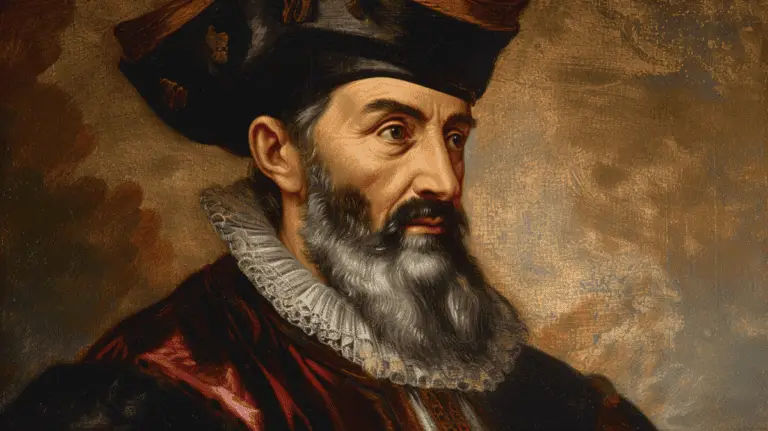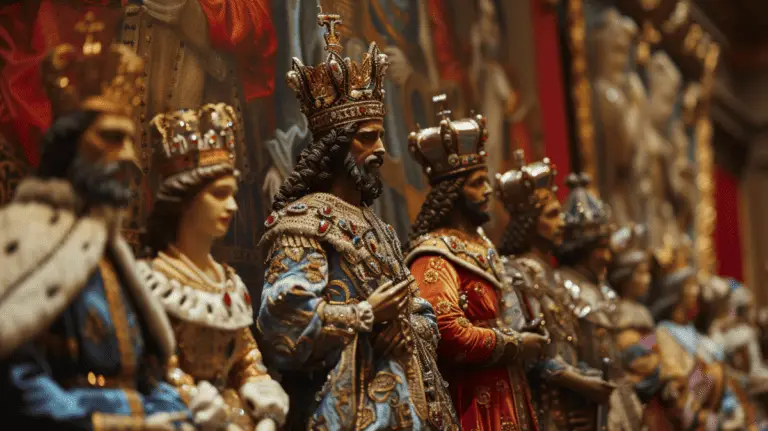The Life and Legacy of Luís de Camões
Luis De Camoes, born around 1524/25 in Lisbon, Portugal, is a name that resonates deeply in the hearts of the Portuguese people. Known as Portugal’s great national poet, his works have had a profound and lasting impact on Portuguese and Brazilian literature alike.
Early Life and Adventures
Camoes was born into an impoverished aristocratic family but was well-connected to the grandees of Portugal and Spain. His early life was filled with adventure and hardship. He is believed to have spent his youth in territories held by the Portuguese in Morocco, either as an exile or as a young aristocrat starting a military career.His life was a series of adventures, from military incursions to intense forbidden romances. He was an extremely sensitive man who had to overcome challenges due to his impulsive nature and face poverty on more than one occasion.
Luís de Camões is widely believed to have lost his eye during military service, although the exact circumstances are a mix of historical record and legend. The most commonly accepted story is that he lost his eye in combat during a military expedition in North Africa. Camões served in the Portuguese army, and it was during these campaigns, specifically in Ceuta, a Portuguese stronghold in North Africa, that he is said to have sustained an injury resulting in the loss of his eye.
Details about how exactly the injury occurred are sparse and vary among sources, with some suggesting it happened during a battle or skirmish. Despite the lack of precise historical details, this aspect of Camões’s life contributes to the romanticized image of the poet as a heroic figure who endured significant hardships, including military battles, shipwrecks, and imprisonment.

Literary Works and Achievements
Camoes is best known for his epic poem, “Os Lusíadas” (The Lusiads), published in 1572. This masterpiece describes Vasco da Gama’s discovery of the sea route to India and extols the glorious deeds of the Portuguese. His work achieved a remarkable harmony between classical learning and practical experience, expressing through them the gravity of thought and the finest human emotions.In addition to his epic, Camoes also wrote a considerable amount of lyrical poetry. His collection of poetry, “The Parnasum of Luís de Camões”, was unfortunately lost during his lifetime. Despite this, his lyrical works, among which are some of the loveliest ever written, have given him a lasting claim to fame.
Works by Luis De Camoes
Epic Poetry
- “Os Lusíadas” (The Lusiads): Camoes’ most famous epic poem, published in 1572, which celebrates the Portuguese explorations and the discovery of a sea route to India by Vasco da Gama.
Lyric Poetry
- “Sonetos de Camões” (Sonnets of Camoes): A collection of sonnets that showcases Camoes’ mastery of lyrical verse.
- “The Lyricks”: This includes various forms of lyrical poetry such as odes, elegies, and canzones1.
- “Rimas” (Rhymes): Published posthumously in 1595, this collection includes sonnets, eclogues, odes, cantigas, and more.
Dramatic Works
- “Auto de Filodemo”: A play by Camoes.
- “El-Rei Seleuco” (King Seleucus): Another dramatic work attributed to Camoes.
- “Anfitriões” (The Amphytrions): A play that is part of Camoes’ dramatic oeuvre.
Other Works
- “The Parnasum of Luis Vaz”: A collection of poetry that was unfortunately lost during Camoes’ lifetime.
- “Letter”: Camoes also wrote letters, one of which is noted in the list of his works.
- “Auto El-rei Seleuco”: This is another dramatic work, distinct from the previously mentioned “El-Rei Seleuco”.
Posthumous Collections
- “Obras Completas de Luis de Camões” (Complete Works of Luis de Camoes): This includes all of Camoes’ works compiled into complete editions.
The Epic Tale of Os Lusiadas
Luis De Camoes, Portugal’s national poet, is best known for his epic poem “Os Lusiadas,” often translated as “The Lusiads.” This masterpiece, first published in 1572, is widely regarded as the most significant work of Portuguese-language literature and is frequently compared to Virgil’s “Aeneid”.

The Story Behind Os Lusiadas
“Os Lusiadas” is a fantastical interpretation of the Portuguese voyages of discovery during the 15th and 16th centuries, focusing primarily on the journey of Vasco da Gama, the Portuguese explorer who discovered the sea route to India. The poem is written in the Homeric fashion, with the narrative starting in the midst of the action, known as in medias res, and the background story being told later in the epic.The poem is divided into ten cantos, each with a different number of stanzas, totaling 1,102 stanzas. It is written in the decasyllabic ottava rima, which has the rhyme scheme ABABABCC, and contains a total of 8816 lines of verse.
The Journey of Vasco da Gama
The action of the poem begins after an introduction, an invocation, and a dedication to King Sebastian. Da Gama’s ships are already under way in the Indian Ocean, sailing up the coast of East Africa. The gods of Greco-Roman mythology gather to discuss the fate of the expedition, which is favored by Venus and attacked by Bacchus.During a stop in Melinde on the east coast of Africa, at the request of the king of Melinde, da Gama recounts the entire history of Portugal, from its origins to the inception of their great voyage. These cantos contain some of the most compelling passages in the poem.When they reembark, Bacchus tries to arrange the shipwreck of the Portuguese fleet but is prevented by Venus, and da Gama is able to reach his destination, Calicut (Kozhikode, now in Kerala state, southwestern India) on the Malabar Coast.
The Return Journey and the Isle of Love
On their homeward voyage, the mariners chance upon the island Venus has created for them, and the nymphs reward them for their labours. One of the nymphs sings of the future deeds of the Portuguese, and the entertainment ends with a description of the universe given by da Gama and the Nereid Thetis. The sailors again set sail for home.The Isle of Love, which occupies most of the last two cantos of the poem, is another paradisiacal site whose sumptuous entertainment blatantly distracts da Gama from his imperial mission. The sexual union of Portuguese sailors and Venusian sea-nymphs is interpreted as a symbol of “Portugal’s glory and lordship3.
The Legacy of Os Lusiadas
“Os Lusiadas” is often regarded as Portugal’s national epic, much as Virgil’s “Aeneid” was for the Ancient Romans, or Homer’s “Iliad” and “Odyssey” for the Ancient Greeks. It was written when Camões was an exile in Macau and was first printed in 1572, three years after the author returned from the Indies.The poem celebrates the glorious deeds of Portuguese explorers, who are sometimes helped and sometimes hindered by Greek and Roman gods. It is a testament to the bravery, determination, and navigational skills of the Portuguese explorers, and a tribute to the spirit of discovery that defined an era.
Impact and Legacy
Camoes’ influence extends beyond his literary contributions. He is regarded as a symbol of Portugal, and the anniversary of his death on June 10, 1580, is observed as the country’s national day. His works remain pivotal to the teaching of Portuguese literature, from primary school to tertiary institutions. Camoes also played a significant role in building Portuguese cultural identity and global outreach. His writings chimed with the Portuguese ideals of the time – of glory, expansionism, and cultural transmission.His legacy is celebrated worldwide through a series of cultural events. In Macau alone, “Month of Portugal” – co-organised by the Portuguese consulate and Lusophone associations – hosts around 25 activities.
In conclusion, Luis De Camoes was not just a poet; he was a symbol of Portugal’s national identity and a beacon of its cultural heritage. His works continue to inspire and educate, making him a timeless figure in the annals of Portuguese literature.







